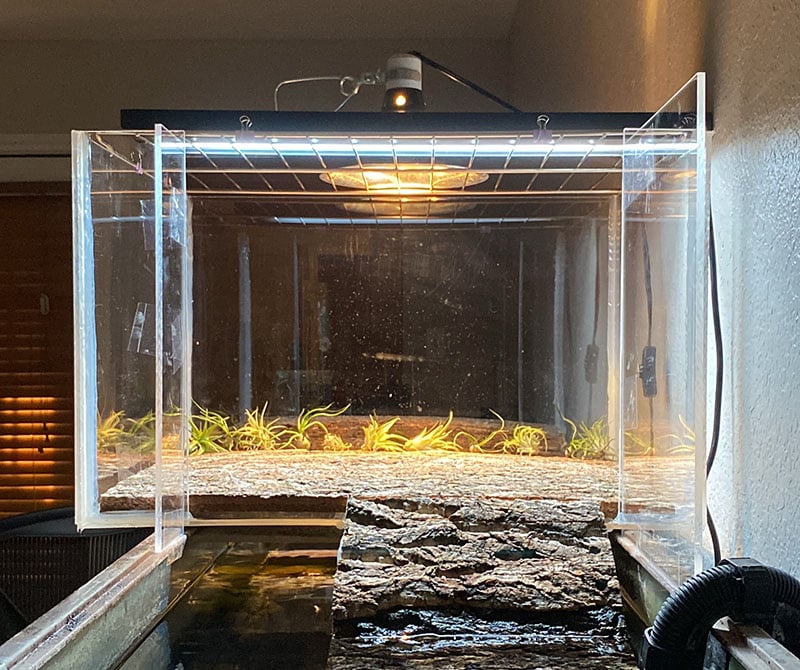To build a basking area for turtles, use a sturdy platform with a non-toxic ramp for easy access. Incorporate a heat lamp for proper temperature regulation.
Creating a basking area is crucial for the health and well-being of turtles, as it mimics their natural habitat and allows them to regulate their body temperature effectively. By providing a designated spot for basking, you are helping your turtle maintain its overall health and vitality.
In this guide, we will explore the steps involved in setting up a basking area that meets the specific needs of your turtle. Let’s dive in and learn how to create a comfortable and safe basking spot for your shelled companion.
Selecting The Right Materials
When building a basking area for turtles, it’s crucial to select the right materials. Opt for non-toxic, easy-to-clean materials like smooth rocks, logs, or commercial turtle platforms. Creating a comfortable basking spot will ensure your turtle’s health and happiness.
Choosing A Suitable Container
Selecting Safe And Non-toxic Materials
When building a basking area for turtles, the materials you choose are crucial. Selecting safe and non-toxic materials is essential to ensure the well-being of your pet. Avoid materials that could harm your turtles. Choose a container that is large enough for your turtle to comfortably bask in. Opt for a non-porous material such as plastic or glass to prevent water leakage. Use natural materials like rocks and driftwood to create a naturalistic basking area. Avoid using treated wood or rocks that may contain harmful chemicals. Ensure all materials are clean and free of any sharp edges that could injure your turtle. Regularly clean and disinfect the basking area to maintain a healthy environment for your pet. Remember that the safety and well-being of your turtle should always come first when selecting materials for their basking area. Choose wisely to provide a safe and comfortable space for your beloved pet.
Credit: dfwcrafts.com
Designing The Basking Area
Designing the basking area for your turtles is an essential aspect of creating a comfortable and safe environment for them. A well-designed basking area will provide your turtles with a spot where they can dry off, regulate their body temperature, and bask under the heat and UVB rays. When designing the basking area, there are a few key elements to consider to ensure it meets the needs of your turtles.
Creating A Gradual Slope
When it comes to creating a basking area for your turtles, it’s important to incorporate a gradual slope in the design. This allows your turtles to easily access the basking area and provides them with a naturalistic environment to climb and bask. To create a gradual slope, you can use a combination of smooth rocks, driftwood, or specially designed ramps to provide a gentle incline that allows easy access to the basking platform.
Incorporating A Secure Platform
Another crucial aspect of designing the basking area for your turtles is incorporating a secure platform. The platform should be large enough to accommodate all of your turtles and provide enough space for them to bask comfortably. It’s essential to ensure that the platform is stable and securely anchored to prevent any accidents or injuries. You can use materials such as ceramic tiles, flat rocks, or specially designed basking platforms to create a stable and secure basking area for your turtles.
Adding Heat And Light Sources
To create a basking area for turtles, integrate appropriate heat and light sources. Ensure the basking spot mimics their natural habitat for optimal health and well-being. Adjust the temperature and lighting to meet the specific needs of your turtle species.
Turtles are cold-blooded creatures and require heat to regulate their body temperature. In the wild, they bask in the sun to raise their body temperature, but in captivity, they need an artificial basking area. A basking area should have both heat and light sources. Here are some tips on how to add heat and light sources to your turtle’s basking area.Choosing The Right Basking Lamp
When it comes to choosing the right basking lamp, it’s important to consider the size of your turtle and the size of the basking area. A general rule of thumb is to use a lamp that provides 5-10 watts per gallon of water in the tank. For example, if you have a 40-gallon tank, you would need a 200-400 watt lamp. There are two types of basking lamps: halogen and incandescent. Halogen lamps are more energy-efficient and provide a brighter light than incandescent lamps. However, incandescent lamps are cheaper and more readily available. It’s important to choose a lamp that emits both UVA and UVB rays. UVA rays stimulate appetite and activity, while UVB rays promote vitamin D3 synthesis.Positioning The Heat Source Correctly
Positioning the heat source correctly is crucial to ensure your turtle’s basking area is at the right temperature. The heat source should be positioned above the basking area, and the distance between the lamp and the basking area should be around 12-18 inches. It’s also important to use a thermometer to monitor the temperature of the basking area. The basking area should be between 85-90°F for most turtle species. If the temperature is too low, your turtle won’t be able to regulate its body temperature, and if it’s too high, it can cause overheating and dehydration. In conclusion, adding heat and light sources to your turtle’s basking area is essential for their health and well-being. Choosing the right basking lamp and positioning the heat source correctly will ensure that your turtle has a comfortable and safe basking area.Ensuring Proper Maintenance
Proper maintenance of the basking area is crucial for the health and well-being of your turtles. By ensuring regular cleaning and disinfecting, as well as monitoring temperature and humidity levels, you can create a comfortable and safe environment for your shelled companions.
Cleaning And Disinfecting Regularly
Regular cleaning and disinfecting of the basking area is essential to prevent the buildup of bacteria and algae. Use a mild soap or reptile-safe disinfectant to clean the basking platform and surrounding surfaces. Rinse thoroughly to remove any residue, and allow the area to dry completely before reintroducing your turtles.
Monitoring Temperature And Humidity Levels
Regular monitoring of temperature and humidity levels is crucial for the overall well-being of your turtles. Use a reliable thermometer and hygrometer to ensure that the basking area maintains the optimal temperature and humidity. Adjust the heating and misting systems as needed to maintain the ideal conditions for your turtles.
Introducing Safe Plants And Decor
Turtles require a basking area in their habitat to regulate their body temperature and stay healthy. When creating a basking area for turtles, it’s important to introduce safe plants and decor to ensure a conducive and natural environment for these reptiles. By selecting turtle-safe plants and avoiding harmful decorative items, you can enhance the well-being of your pet turtle while also creating an aesthetically pleasing environment.
Selecting Turtle-safe Plants
When choosing plants for your turtle’s basking area, it’s essential to opt for non-toxic varieties that can withstand the conditions of a semi-aquatic environment. Some suitable turtle-safe plants include:
- Anubias
- Duckweed
- Water lettuce
- Java fern
Avoiding Harmful Decorative Items
While decorating the basking area, it’s crucial to steer clear of items that could pose a threat to your turtle’s well-being. Avoid using decorative items such as:
- Sharp rocks or stones
- Plastic plants with small parts that can be ingested
- Artificial dyes or paints that may be toxic
- Items treated with chemicals or pesticides
Monitoring Turtle Behavior
Discover how to create a basking spot for turtles to monitor their behavior effectively. Enhance your pet’s well-being by providing a warm and safe area for them to relax and soak up essential UV rays. Follow these simple steps to build a comfortable basking spot that meets your turtle’s needs.
Turtles are fascinating creatures that spend most of their lives in water. However, they need to bask under a heat source to regulate their body temperature, digestion, and overall health. Building a basking area for your pet turtle is one of the best ways to provide them with a comfortable and healthy living environment. But how do you know if your turtle is basking correctly? Monitoring your turtle’s behavior is key to ensuring they are healthy and happy. In this post, we will discuss the importance of observing your turtle’s basking patterns and noting any unusual behavior.Observing Basking Patterns
One of the most important things to monitor when it comes to your turtle’s behavior is their basking patterns. Turtles are ectothermic, meaning they rely on external sources of heat to regulate their body temperature. Therefore, they need a basking area with a heat source that provides them with warmth and UV light. You should observe your turtle’s basking patterns to ensure they are spending enough time under the heat source. If they are not basking enough, they may become lethargic, lose their appetite, or develop health problems.Noting Any Unusual Behavior
It is also important to note any unusual behavior your turtle may exhibit while basking. For example, if your turtle is consistently basking on one side of their body, it may indicate a health problem. Additionally, if your turtle is not basking at all, it could be a sign of stress or illness. Other things to look out for include changes in appetite, lethargy, and abnormal swimming behavior. If you notice any of these behaviors, it is essential to consult with a veterinarian who specializes in reptile care. In conclusion, monitoring your turtle’s behavior is crucial to ensuring they are healthy and happy. Observing their basking patterns and noting any unusual behavior will help you identify any potential health problems early on. By providing your turtle with a comfortable and healthy basking area, you can help them thrive in their environment.Ensuring Safety Measures
When building a basking area for turtles, ensuring safety measures is crucial to providing a secure and comfortable environment for your pet. By taking the necessary precautions, you can prevent accidents and create a safe space for your turtle to bask and relax.
Preventing Escapes
One of the primary safety concerns when building a basking area for turtles is preventing escapes. Turtles are known for their curiosity and may attempt to explore beyond their designated area. To mitigate the risk of escape, it’s essential to ensure that the enclosure is secure and escape-proof.
Eliminating Sharp Edges And Hazards
Sharp edges and hazards within the basking area can pose a threat to your turtle’s well-being. It’s important to inspect the enclosure for any sharp or protruding edges that could potentially injure your pet. Additionally, removing any small objects or potential choking hazards from the basking area is essential to safeguarding your turtle’s safety.

Credit: www.reddit.com
Seeking Veterinary Advice
Consulting A Reptile Veterinarian
When building a basking area for your turtle, consult a reptile veterinarian.
Addressing Any Health Concerns
Ensure to address any health concerns with the veterinarian for your turtle’s well-being.

Credit: www.youtube.com
Conclusion
Incorporating a basking area for your turtle is crucial for their well-being. By following the steps outlined in this guide, you can create a comfortable and safe space for your pet. Remember, providing the right environment is essential for your turtle’s health and happiness.
Start building today!






Leave a Reply